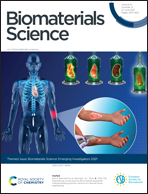Cu2−xSe/Bi2Se3@PEG Z-scheme heterostructure: a multimode bioimaging guided theranostic agent with enhanced photo/chemodynamic and photothermal therapy†
Abstract
Photodynamic therapy (PDT) can be defined as a kind of intracellular photocatalysis. Inspired by the design of photocatalysts, the construction of the heterojunction also is expected to improve the production of reactive oxygen species (ROS) for PDT. Herein, the Cu2−xSe/Bi2Se3@PEG (CB3@PEG) nano-heterostructure has been prepared by a cation-exchange process, where the interaction between the host and exchange agent is vital. CB3@PEG exhibits the near-infrared (NIR)-triggered hydroxyl radical and singlet oxygen (˙OH and 1O2) generation, which is more than 6 times in contrast with that of pure Cu2−xSe@PEG, attributed to the Z-scheme charge transfer mechanism with the high redox ability and great charge separation. Moreover, with the narrower band gap of Bi2Se3, CB3@PEG exhibits enhanced NIR harvest as well as high photothermal conversion efficiency (60.4%). Due to the Fenton reaction caused by the Cu ion, CB3@PEG is endowed with the chemodynamic therapy (CDT) and signal-enhanced T1-weight magnetic resonance imaging (MRI) capacity. In addition, the great photothermal ability and X-ray absorption coefficient provide outstanding contrast in photothermal imaging (PTI) and computerized tomography (CT) imaging. Finally, the multi-imaging combined with the synergistic treatment (PTT/CDT/PDT) makes CB3@PEG achieve enhanced efficiency in anticancer therapy.



 Please wait while we load your content...
Please wait while we load your content...